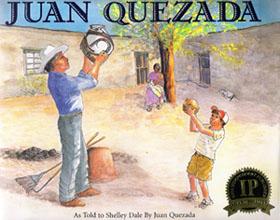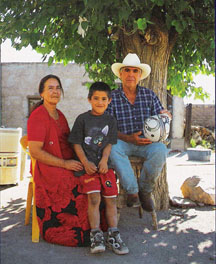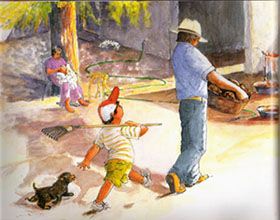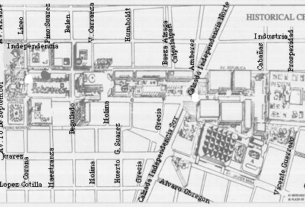Good Reading
 Juan Quezada
Juan Quezada
As told to Shelley Dale by Juan Quezada
Illustrated by Shelley Dale
Norman Books (Santa Monica, CA 90403)
Here in Ajijic on a cold night a week or two ago, my nine-year old Mexican daughter Gabriela and I curled up in a couple of wool blankets and read to each other. Gaby held in her hands the Spanish version of Juan Quezada and I held the English version. As we read through the book, Gaby first read aloud, a page at a time, in Spanish and then I read aloud the same page in English. While I read back to her in English, Gaby studied the charming illustrations by Shelley Dale, who also wrote the story as told to her by Juan Quezada himself.
The story begins this way:
This is a true story. t is the story of how one curious and determined boy changed the future of his poor, nearly abandoned village in Northern Chihuahua, Mexico. Today, the boy, Juan Quezada Celado, is a famous artist. His village of Mata Ortiz, a village of potters, is known all over the world.
Before even moving to Mexico I had admired the Mata Ortiz pottery I had seen in shops in Taos and Santa Fe. This story, then, about Juan Ortiz, was of interest to me before I even opened the book. To Gaby, the story was interesting partly because she loved looking at the illustrations.

In this story, Chato, the grandson of Juan Quezada, asks his abuelito, his grandfather, to tell him once again the story “about the special day.” While his grandmother burnishes one of the finished pots and while his grandfather waits for his pots to cool, he begins to tell the story.
When he was thirteen he collected firewood with his burro, “Minuto.” The grandfather tells Chato, “We’d see ruinas from the ancient people. There were large cooking pits where they boiled the agave plants into syrup. I’d find shards, broken pieces of hard, baked clay. Some were blackened from cooking fires, but others had beautiful colors. I wanted to know how the ancients had made this colored barro.”
Although the old people in his poor pueblo had forgotten how to make painted clay pots, Juan experimented. Searching for the ancient secrets, he came upon a hidden cave, and “Inside the cueva, I found a three-legged stool, a calabaza cup, pieces of woven yucca zapatos and…”

What he found was an ancient olla, a pot, unbroken, which he then began to study.
Thus begins this story of Juan Quezada and Mata Ortiz pottery and of the resurrection of this poor village in Chihuahua. Eventually a stranger, Spencer MacCallum, comes knocking at his door, looking for the man who had made the incredible pottery he had found in New Mexico. Spencer MacCallum offers his help.
As in the excerpts I have quoted, Shelley Dale, throughout the English version of this little book, introduces some Spanish words without including their meaning in English. They are clear from the context or as cognates, but should any confusion remain, she includes in the English version a short Glossary and guide to phonetic pronunciation. For example: ” ollita….oy ‘yee tah…..small pot.”
Following the glossary is a three-page history of the area from ancient times to modern times. Toward the end of this history she writes that “By the 1960s the railroad, lumber company and most of the people had abandoned remote Mata Ortiz for opportunities elsewhere. Juan Quezada’s family was one of the few that remained.”
“In 1976, when Spencer MacCallum knocked on Juan’s door, Juan was 36. It had taken him twenty two years of experimenting to single-handedly revive the Casas Grandes pottery tradition. Juan thinks of his accomplishment as ‘a gift from God.'”
This history is followed by another page, How Does Juan Find His Clay? A K-6 Lesson Plan that “meets national standards” concludes the book.
Although Juan Quezada is presented as a children’s book, I think it is also a fine book for adults who collect or who are interested in Mata Ortiz pottery. It is the story of a boy who became fascinated by an ancient art, re-discovered it, and thereby, with the help of his American friend, created a better life for his little village, now a thriving village of potters.
Gaby must have fallen asleep that night dreaming about pottery, because when she came home from school the following day, she went right to work making “mud pots” and setting them in the sun to dry.
Available from Amazon Books: Hardcover (English)
(Spanish)


